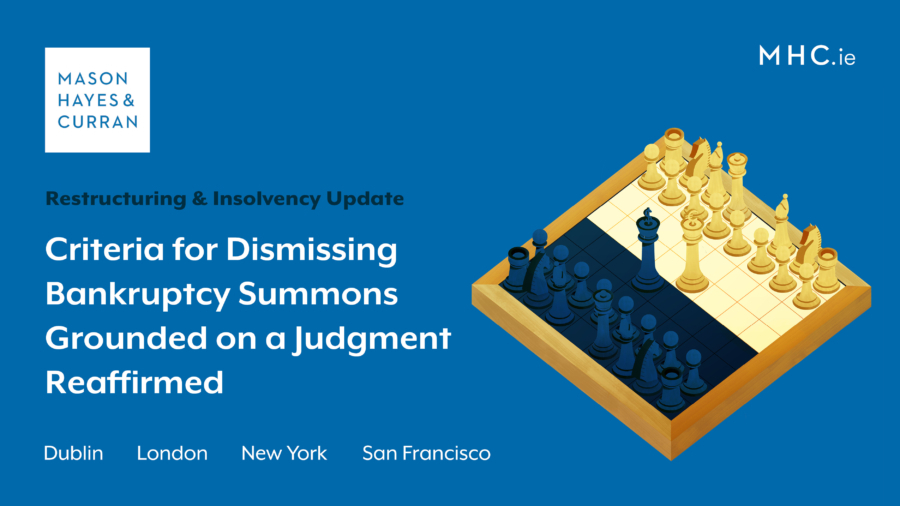Criteria for Dismissing Bankruptcy Summons Grounded on a Judgment Reaffirmed

The High Court has reaffirmed the test to be applied in considering an application to dismiss a bankruptcy summons grounded on a judgment.
The bankruptcy process in Ireland involves multiple steps and the debtor can seek to bring it to a halt at each step. Debtors often seek to rerun effectively the same arguments at each step, ignoring previous findings by the courts. One such step is an application to dismiss a bankruptcy summons.
In Doherty v Blessville[1] the High Court reiterated that:
- to dismiss a bankruptcy summons, the debtor must show a real and substantial issue arises for trial; and
- it is almost impossible to reach this threshold where the bankruptcy summons is grounded on a judgment.
Background
Blessville Unlimited Company (the Creditor) obtained judgment against Mr Doherty (the Debtor), embodied in two court orders (the Orders) issued in 2019 and 2020. It then obtained an order for the issue of a bankruptcy summons.
The Debtor applied to have the bankruptcy summons dismissed.
Section 8(6) of the Bankruptcy Act 1988 provides:
“The Court—
(a) may dismiss the summons with or without costs, and
(b) shall dismiss the summons if satisfied that an issue would arise for trial”
Amongst other things, the Debtor sought to dispute the debt and asserted that one of the Orders was ambiguous.
Relevant case law
The Court considered the judgment in Minister for Communications, Energy and Natural Resources v. Wood,[2] where Dunne J. stated:
“…Thus, in order for an application to dismiss a bankruptcy summons to succeed, the issue raised by an applicant must be a real and substantial issue. It should not be fanciful or unreal. It may be an issue of fact or law. If the issue raised is an issue of fact it must have some credibility. If, for example, the applicant for an order pursuant to s. 8(6)(b) of the Act of 1988 denies that he owes the money sought in a bankruptcy summons but has already suffered judgment in that amount, then the conclusion that he or she did not owe the money would simply not be credible.”
Decision
The Court noted that:
“There may well be exceptional cases where it will be appropriate to go behind a judgement that has been granted previously. I do not rule out such a possibility where a debtor puts forward cogent evidence that calls into question the reliability or fairness of the earlier proceedings. For instance, were a debtor to establish prima facie proof that the earlier judgement was procured by fraud or mistake, or in circumstances of fundamental unfairness such that it should be set aside, then the interests of justice might necessitate at least a revisiting of the earlier Order.”
However, it held that the Debtor came nowhere near demonstrating why the Orders should be set aside.
Ultimately it held that “the Debtor faces an insurmountable difficulty arising from the existence and contents of the order of Pilkington J. … The fact of the matter is that that order was never appealed and nor was any application made to have it set aside or otherwise revisited.”
Comment
This decision is a clear reiteration of the criteria to be applied when considering an application to dismiss a bankruptcy summons grounded on a judgment.
If a debtor wishes to challenge a judgment, that should be done by way of appeal or an application to set it aside. It is not open to a debtor to sit on his or her hands and seek to look behind a judgment in an application to dismiss a bankruptcy summons.
Moreover, looking behind a judgment in an application to dismiss a bankruptcy summons would require cogent evidence of something exceptional such as prima facie proof that the judgment was obtained by fraud, mistake or fundamental unfairness.
For more information and expert advice, contact a member of our Restructuring & Insolvency team.
The content of this article is provided for information purposes only and does not constitute legal or other advice.
[1] [2023] IEHC 543.
[2] [2017] IESC 16
Share this:







